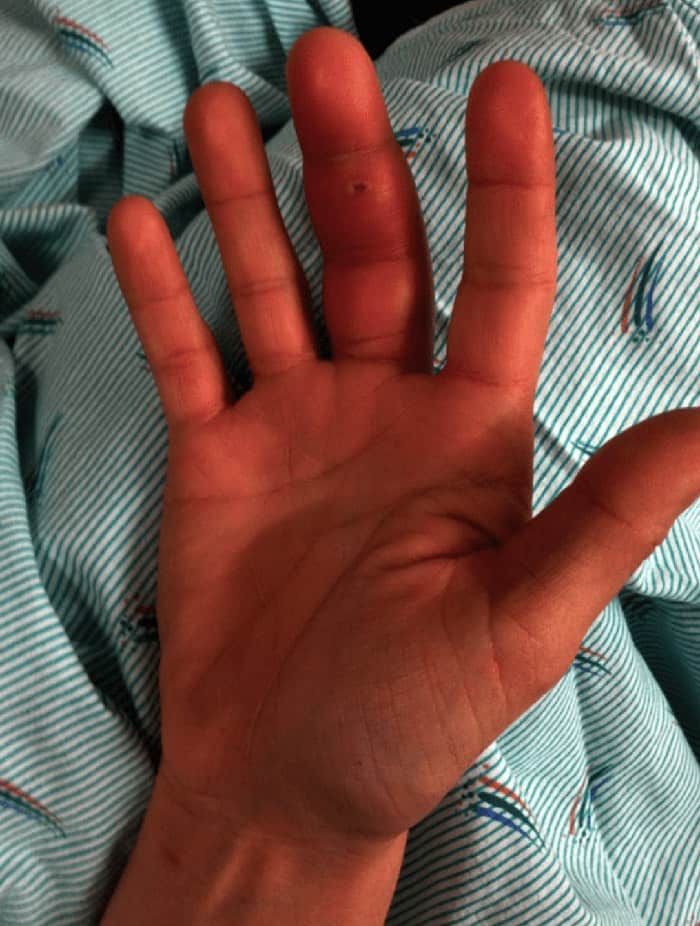Infection of the flexor tendon sheaths of the hand, represents a potential surgical emergency, due to these being closed compartments and swelling can result in necrosis. The same does not tend to occur in extensor tendons as they are open compartments.
Infections to the flexor tendon sheath usually occur following a penetrating injury to the hand. The infection course can be surprisingly rapid and aggressive. Beware the immunocompromised patient, as they can have a much more rapid deterioration. The infection can result, in its mildness form, in some tightness and restriction of movement in the tendon involved. In its most serious form, it can cause tendon necrosis, loss of limb, or even mortality.
In most cases the decision for surgical intervention and washout is a clinical one. Inflammatory markers such as white cell count and C-reactive protein do not help if they are normal, as their negative predictive value is approximately 4% and 13% respectively(1).
Kanavel’s sign(2) is a clinical sign made up of four parts. It assists in predicting pyogenic flexor tenosynovitis of the hand, however has never been validated. Also the absence of one or more of it’s parts does not exclude the condition. In fact all four parts have been found to occur in only about 50% of cases(3)
The sign consists of four parts:
1 Flexed posture of the finger: The finger is held in slight flexion for comfort.
2 Circumferential swelling of the finger.
3 Percussion Tenderness along the whole length of the Flexor sheath .
4 Severe Pain if attempt to extend the affected finger.
Tenderness along the length of the tendon sheath tends to be a late sign, but an important one. Perhaps the most frequent sign is the circumferential swelling of the finger(4), but the most helpful may be severe pain on finger passive extension(5).
The signs may also be less prominent in the thumb and fifth finger as these become the radial and ulnar bursa respectively, providing decompression.
The most common organisms involved include:
1 Staphylococcus aureus
2 MRSA
3 Pseudomonas aeruginosa
4 Streptococcus species
However rarer organisms such as Pasteurella, Listeria. Neisseria gonorrhoea and Clostridium.
The bottom line, is be careful not to send these patients home. An infected swollen finger that is painful to move, needs to be assessed by the hand surgeons in your hospital.
References:
1 Bishop GB, Born T, Kakar S, Jawa A. The diagnostic accuracy of inflammatory blood markers for purulent flexor tenosynovitis. J Hand Surg Am 2013;38:2208-2211
2 Kanavel AB. The symptoms, signs, and diagnosis of tenosynovitis and fascial-space abscesses. In Infections of the Hand. 1st ed. Philadelphia, PA: Lea & Febiger; 1912:201–226.
3 Dailiana ZH, Rigopoulos N, Varitimidis S, Hantes M, Bargiotas K, Malizos KN. Purulent flexor tenosynovitis: factors influencing the functional outcome. J Hand Surg Eur. 2008;33:280–285.
4 Pang HN, Teoh LC, Yam AK, Lee JY, Puhaindran ME, Tan AB. Factors affecting the prognosis of pyogenic flexor tenosynovitis. J Bone Joint Surg Am. 2007;89:1742–1748.
5 Neviaser RJ, Gunther SF. Tenosynovial infections in the hand: diagnosis and management. Instr Course Lect. 1980;29:108–128










